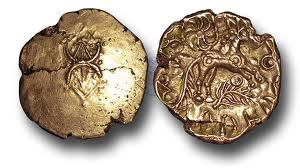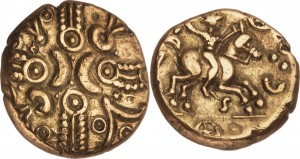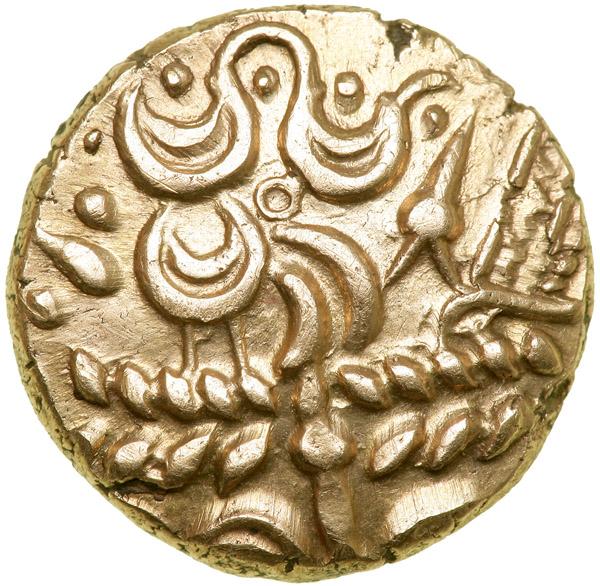The mysterious symbolism of the horse pervades the artwork of the coins of the Iron Age Celtic peoples of Atlantic Europe. From the Thracian Celts of the Balkan region, to the tribes of Britain, Gaul and Hispania – all produced coins which depicted a strange and compelling set of images, perhaps providing a clue to the supra-regional religion of the peoples classified by the Greeks and Romans as the ‘barbarians’.

Celtic (Scordisci) coin from the Balkans depicting a woman riding a horse (?2ndC BCE). Note the apparent astronomical designs!
The history of coinage among the Celtic peoples lies in their economic links to the ancient Greek world – in particular through southern Gaul, Macedonia and Thracia at the height of Hellenic influence, and the Empire of Alexander the Great and his successors. For this reason, the design of celtic coins was afterwards strongly influenced by the format of the Macedonian/Greek ones, some of which depicted the horned head of ‘Alexander’, sometimes Apollo, Hercules or Zeus on one side….

Depiction of Alexander (with horns) on a greek coin of the 3rdC BCE
Due to trade links with celtic tribes through southern Gaul (from 6thC BCE) and trade and warfare with the Illyrian, Pannonian, Dacian, Thracian and eastern Celtic peoples as well as marauding incursions of western Gauls , the indigenous style of coinage developed in the 4thC BCE generally copied the Macedonian and Greek format and typically showed a depiction of ‘Alexander’ on one side – an icon which would become increasingly stylised:

Coin of the Parisii ca. 1stC BCE. Note the depiction of the martial charioteer – apparently female, in the role of a ‘Badbh Catha’, seemingly trampling an ‘angel’ into the dust….

Trinovantes, Britain, 1stC BCE – what happened to Alexander’s head?
The celts seem to have taken the symbolism of the Greek coins further than the original format… to recap, here is a typical Greek tetradrachm from the 3rdC BCE:

Tetradrachm of Phillip II of Macedon – note the ‘Dioskouros’ on the obverse face… one of the famous Hellenic horseman-deities who would have been so popular in the ancient Balkans and steppes north of the Black Sea.
Ostensibly starting with a picture of Alexander’s father Phillip II the coins of the era of Alexander gloried in the imagery of the head of the conquering hero, and evolved between depictions of humans (Philip, Alexander) and gods (Apollo, Zeus, Herakles) depending on how successful and grandiose the ruler who minted them felt himself. In the fragmented succession period that followed Alexander’s death, depicting a god was often a safer bet than advertising your discombobulated head…. The totemic value of the Mercurial ‘Alexander’ among the peoples of Europe’s highly mobile barbarian warrior culture (in the La Tene period) cannot be underestimated, and it is perhaps unsurprising that they would copy the coins of the world’s most astounding military leader, whose legend had elevated him to a godlike status. Vast numbers of Celtic warriors had poured across and down through the Balkans in the 3rd century, culminating with an assault on Delphi itself, and many would afterwards find employment within the Seleucid Empire on account of their warrior prowess, just as ‘Viking’ warriors would in the Byzantine Roman Empire during the 8th-11th centuries.
Belgic tribes like the Parisii (northern France) and their cousins among the Icenii, Trinovantes and Catuvellauni (eastern Britain) produced a great deal of the most interesting and beautiful coins which elaborated on and converted the Greek template designs to meet their own system of material and religious values. In the 3rd-1stC BCE their increasing power was no doubt bought about by trade (and pillage) with the Greek and increasingly powerful Roman worlds, which demanded or received coinage.
We can tell that these tribes were powerful and influential due to the fact that they modified the design of their coins away from the Greek, demonstrating to the world their own culture and beliefs. They obviously understood the symbolism of the greek coins, but were to express their own through some significant changes and additions.
The coins of the Parisii (who occupied the region along the Seine) were typified by placing a star symbol under the front hooves of the horse, which was constructed of a circular arrangement of 6 (sometimes 5) dots. The other interesting feature of their coins was the ‘net’ design in the shape of a ‘tented inverted triangle’ above the serpentine horse, which usually faces left and is riderless. The Parisii further modified the coin template by feminising the head on the obverse side. Tree branch designs often decorate either side. There are no ‘sun wheels’ as seen in many British coins.

Alexander has become a woman on this Parisii coin!
Across the water in Britain, their cousins the Trinovantes must have watched in dismay, as well as interest as the Parisii and the rest of Gaul succumbed to Julius Caesar and his Roman legions in 52BC. They were another great and wealthy tribe, who – along with their neighbours the Icenii and Catuvellauni – stood to become increasingly wealthy from contact (and alliance) with Rome. Their coins from this period demonstrate a more definite split from the Greek designs of the western European celts – perhaps showing more in common with their central European cousins who also excelled in stylising, perhaps when they too felt the pressure of Roman encroachment.
The Trinovantes coins show a number of variations on the theme from the Parisii. Firstly – like other British coins, they do not show the ‘net’ design above the horse, instead favouring a sun symbol (usually depicted as a wheel) and/or a branch. Like the Parisii coins, the ‘star’ symbol also often occurs under the horse’s front feet, but this seems an inconsistent feature – usually depicted as a circle surrounding a point. The horse, branch and sun symbols are more realistic and less stylised, either demonstrating the fact that they were more advanced artisans or perhaps due to the fact these coins are generally from a later date. Of greater interest is the fact that they do away with the head on the obverse side and replace it with symbolic images:

Coin of Addedomaros of the Trinovantes (1stC BCE) – note the reflected heads of corn. These have stylistic echoes of Alexander’s headband or horn…
The corn/barley design was probably another borrowing from Greek coinage, but here it might also (during the 1stC BCE/1stC CE) represent the Trinovantes advertising their commercial wares to the Romans and other tribes of Britain: Beer and grains. Their territories were fertile and they had good access to the sea to supply those made hungry by war and famine, over the horizon in the brewing storm of the Roman conquest. Dropping the head of the famous Greek emperor might have represented an act of diplomacy in the face of Caesar’s threatened invasion. Note also the branch under the horse’s feet…
A more explicit depiction of corn, this time barley (similar to the Greek style) appears on another later coin (Cunobelinus of the Catuvellauni in the 1stC CE), but as we shall see it appears to have had a symbolism to the Trinovantes which went beyond mere trade:

Coin of Cunobellinus of the Catuvellauni 1stC AD
To any well-connected and spiritually educated person of the Mediterranean world in the 1stC BCE – 1stC CE, the symbolism of the ear of corn was likely understood as a reference to the Rites of Eleusis held near Athens, and the veneration of Demeter – known to the Romans as ‘Ceres’. That it appears on the coins of Cunobelinus might be a reference to this cult – it is not implausible that he himself was an initiate in what was something akin to the Freemasonic Lodge of Europe’s elite! The rites were a mystery cult dramatizing the story of the annual cycle and the return of Kore (Persephone) from Hades. Caesar’s assertion that Celts such as Cunobelinus believed in reincarnation as instructed by the druids means that they would have had a spiritual sympathy with these rites, whose origins link to the Orphic beliefs originating somewhere in the lower Danube in the late Bronze Age, and hence possibly deriving from the indigenous belief system of the north Europeans. The tie-in between heads of corn and reincarnation is therefore obvious – especially at a time when Druidism and Celtic/Atlantic religion was under great threat.
Let us look at some of the designs replacing the head of Alexander on other Trinovantes coins during this period:

Coin of Adeddomaros – the allusion to heads of corn is gone, and the opposed crescent symbol is more obvious, as is the branch under the horse’s feet.
One cannot help but be overcome with a feeling that the reflective symmetry and structure of the design on the obverse side to the horse is telling us something – much like the pictograms on the early medieval stone stelae of the Scottish celts or ‘Picts’. The same design occurs in other coins of the same period (immediately pre-conquest when druidism had decamped to Britain, and before the Britons began to Romanise).

Iceni coins demonstrating the opposed crescent design, redolent of Pictish symbol stones

The ‘Anarevitos’ coin – noted the mounted rider and cross-symbol

The cross-like symbol with its opposed crescents and solar discs seems to prefigure the ‘celtic cross’ by at least 500 years, and is rich in the symbolism of the annual cycle. The four ‘quarter days’ seem to be represented by the branches (or corn heads) forming the limbs of the cross, and joined to the solar symbols still used in astrology today: a circle with the spot in the middle. Between these are the solstices and equinoxes represented by torcs, rings or lunulae and ‘tented triangles’. In the centre of the cross lie the mysterious apposed lunar crescents – symbol of the months.
The woman riding (side-saddle) on the horse is an innovation that we also see in the Balkan/Danube region (see the first picture above) but here it possibly also gains a martial significance – a people, a goddess and a whole religious way of life readying for war… A small serpentine figure occurs where the ‘star’ often appears – another feature seen in celtic coins from central Europe. Was this symbology copied in an effort to invoke the military success of the central European celts against Macedonia, Greece and then Rome?
Another Belgic tribe who settled in Britain were the Atrebates and their coinage seems to demonstrate similar iconography to that of the Trinovantes and their neighbours.

Note the horse with overhead sun apparently trampling a loose wheel. The pattern on the left is mysterious indeed!
The composition of the imagery may vary in detail, but the obverse side to the horse shows consistent features, seen also in the coins of other tribes, such as the Iceni, Trinovantes, Durotriges etc: separate torcs, linked torcs (the ‘yoke’), crescent-moons, spots, serpentines, ‘corn ears’, branches or wreaths, linear lines, rings and what looks like leaf-shoots. All of these sometimes appearing like a Miróesque deconstruction of the image of Alexander.

More detail on an Atrebates coin – is that a cockerel on the left? The symbolism is perhaps richer and more mysterious than any Greek or Roman coins… These coins provided inspiration for 20thC artists such as Miro and Picasso!
All text © 2014 The Atlantic Religion, except where stated.
























